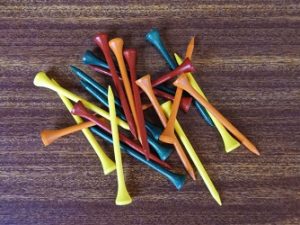Golf tees are an essential piece of equipment for golfers around the world. They are small, wooden or plastic pegs that golfers use to hold their golf balls in place as they prepare to hit their shots. While they may seem simple, there is actually a lot of work that goes into making a golf tee. Here is an overview of the manufacturing process:
- Materials: Golf tees are typically made from either wood or plastic. Wooden tees are typically made from birch or hardwood, while plastic tees are made from a variety of materials, including polycarbonate and polypropylene.
- Cutting: The first step in making a wooden golf tee is to cut the raw material into small pieces using a saw. The pieces are then further cut to the appropriate size and shape for the tee.
- Shaping: Once the raw material has been cut to size, the tees are shaped using a lathe. This machine spins the tee while a cutting tool shapes it into its final form.
- Finishing: After the tees have been shaped, they are sanded to remove any rough edges and to give them a smooth finish.
- Printing: Many golf tees are printed with logos or other designs to help promote a brand or golf course. This is typically done using a silk-screening process.
- Packaging: Once the tees have been finished and printed, they are packaged for shipment to retailers and golf courses.
Additional Details:
Here are some additional details about the process of making golf tees:
- Materials: In addition to wood and plastic, golf tees can also be made from bamboo, which is becoming increasingly popular due to its eco-friendliness and durability.
- Cutting: Wooden tees are typically cut from square or rectangular pieces of wood, which are then turned on a lathe to create the cylindrical shape of the tee. Plastic tees, on the other hand, are often injection-molded, which involves melting the plastic and injecting it into a mold to create the desired shape.
- Shaping: In addition to using a lathe to shape wooden tees, some manufacturers also use CNC (computer numerical control) machines, which allow for more precise and complex shapes.
- Finishing: The process of sanding and finishing wooden tees is important not only for appearance, but also for ensuring that they are smooth and free from splinters that could damage a golfer’s club or hands.
- Printing: Silk-screening is the most common method of printing designs onto golf tees, but some manufacturers also use digital printing or laser etching for more intricate designs.
- Packaging: Golf tees are typically packaged in sets of 10, 25, or 50, and are often sold in small plastic bags or blister packs. Some manufacturers also offer custom packaging options, such as personalized bags or boxes.
Materials used in making golf tees
| Material | Description | Advantages | Disadvantages | Common Use |
|---|---|---|---|---|
| Wood | Natural, biodegradable | Inexpensive, easy to manufacture | Can break easily, not durable | Beginner and recreational golfers |
| Plastic | Durable, lightweight | Can withstand harsh weather conditions | Not environmentally friendly | Professional and serious golfers |
| Bamboo | Eco-friendly, sustainable | Durable, lightweight | More expensive than wood or plastic | Eco-conscious golfers |
| Metal | Durable, long-lasting | Can be reused | Expensive, not biodegradable | Professional and serious golfers |
| Composites | Blend of materials, customizable | Durable, can be designed for specific needs | Expensive, can be difficult to manufacture | Golfers with specific needs (e.g., longer tees) |
Manufacturing processes for golf tees
| Process | Description | Advantages | Disadvantages | Examples |
|---|---|---|---|---|
| Injection molding | Plastic is melted and injected into a mold | Fast, efficient | High startup costs | Pride Golf Tee Company |
| CNC machining | A computer-controlled machine carves the tee from a block of material | Precise, customizable | Slow, expensive | Zero Friction |
| Extrusion | A tube of material is shaped into the tee form | Fast, efficient | Limited shapes and sizes | Greenkeepers |
| Lathing | A lathe machine carves the tee from a piece of material | Precise, customizable | Slow, expensive | Maxfli |
| Stamping | A press machine stamps out the tee from a flat sheet of material | Fast, inexpensive | Limited shapes and sizes | Champ Golf |
Standard sizes and shapes for golf tees
| Size/Shape | Description | Advantages | Disadvantages | Common Use |
|---|---|---|---|---|
| Traditional | 2 1/8 inches long, pointed tip | Easy to use, standard size | Limited use for larger drivers | Beginner and recreational golfers |
| Brush | Bristles that hold the ball off the ground | Less resistance, reduces friction | Can break easily | Professional and serious golfers |
| Zero Friction | Three-pronged design | Low friction, consistent height | Limited use for larger drivers | Professional and serious golfers |
| Martini | Extra-large head, shorter length | Reduced resistance, supports larger ball | Not as durable | Golfers with joint pain or arthritis |
| Claw | Four-pronged design | Low friction, consistent height | Limited use for larger drivers | Professional and serious golf |


